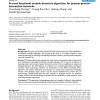Free Online Productivity Tools
i2Speak
i2Symbol
i2OCR
iTex2Img
iWeb2Print
iWeb2Shot
i2Type
iPdf2Split
iPdf2Merge
i2Bopomofo
i2Arabic
i2Style
i2Image
i2PDF
iLatex2Rtf
Sci2ools
129
Voted
ALMOB
2006
2006
A novel functional module detection algorithm for protein-protein interaction networks
Background: The sparse connectivity of protein-protein interaction data sets makes identification of functional modules challenging. The purpose of this study is to critically evaluate a novel clustering technique for clustering and detecting functional modules in protein-protein interaction networks, termed STM. Results: STM selects representative proteins for each cluster and iteratively refines clusters based on a combination of the signal transduced and graph topology. STM is found to be effective at detecting clusters with a diverse range of interaction structures that are significant on measures of biological relevance. The STM approach is compared to six competing approaches including the maximum clique, quasi-clique, minimum cut, betweeness cut and Markov Clustering (MCL) algorithms. The clusters obtained by each technique are compared for enrichment of biological function. STM generates larger clusters and the clusters identified have p-values that are approximately 125-fold ...
Related Content
| Added | 10 Dec 2010 |
| Updated | 10 Dec 2010 |
| Type | Journal |
| Year | 2006 |
| Where | ALMOB |
| Authors | Woochang Hwang, Young-Rae Cho, Aidong Zhang, Murali Ramanathan |
Comments (0)

